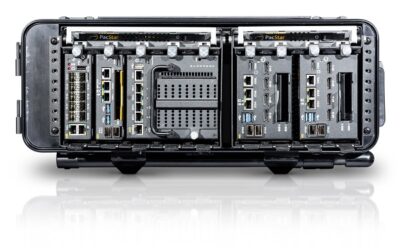US Navy League Sea-Air-Space Exposition Day 1 (9 April 9 2018) End of Day Report
Here’s one instance in the unmanned system maritime domain, of an original equipment manufacturer and its military customer taking their in-service platforms to heretofore, higher standards of operational performance.
Liquid Robotics, a Boeing company, is boldly advancing the technology baseline for its Wave Glider platform. The product is a persistent and highly durable unmanned surface vehicle to support naval core missions including anti-submarine warfare, mine counter measures and ISR. When MONCh spoke at this January’s 2018 Surface Navy League symposium with Don Jagoe, Senior Director for Business Development for US National Security at Liquid Robotics, the technology baseline for the Wave Glider was reported to provide its customer with, “a long duration, highly persistent presence on the surface able to talk to both unmanned underwater vehicles and unmanned air vehicles.”
Mr. Jagoe modestly noted his company’s efforts to flex and advance the capabilities of Wave Gliders include having hosted, “over 55 different industry sensors that are fully integrated into the vehicle and the sensor list is expanding all the time.”
Upon a more recent discussion, the retired US Navy Captain further detailed how Liquid Robotics is taking the Wave Glider to a higher technology plateau. “Our unique paradigm is, by using wave and solar power, that we essentially ‘harvest’ all the power the vehicle uses from the environment. Solar power is derived from onboard solar panels to create electrical energy which is then stored in onboard lithium-ion energy packs to get you through the night. And we use the vertical motion of the waves, independent of direction and speed, and harness energy passively through a mechanical fin arrangement to yield forward propulsion – thus breaking the reliance on a purely battery solution, largely the limiting factor in most unmanned systems today.”
The Wave Glider’s use of energy harvested from the environment permits the platform to remain at sea for extended periods and conduct its missions for months – the community expert said. Further, the current onboard energy plan is sufficient for use of most passive sensors. The addition of many active sensors, including radars, requires an augmenting energy source, battery packs or fuel cells, for example, or adjusting the “duty cycle,” to permit a burst of energy followed by down time to recharge.
Liquid Robotics is also taking on the challenge of the US Navy and two unspecified Asian navies to enable Wave Gliders to operate, “in any sea state at any time of the year, any time of the day and night.”
To permit the Wave Glider to operate in extreme states required some modifications, “to operate in, up to, and including sea state 8-9 [World Meteorological Organization defines this as more than 14 m (46 ft.)]. We are now routinely operating in these conditions in parts of the world that literally have some of the roughest weather found at sea. These are places where ships don’t go because of the adverse impact on people. This is uncharted territory,” Mr. Jagoe emphasised. To meet the rigors of operating in higher latitudes, for instance, Liquid Robotics is also exploring other challenges to support persistent operations, including increasing onboard battery capacity and has successfully overcome the challenges of reliable magnetic compass performance.
Marty Kauchak
























